Candidate Consideration Little Changed
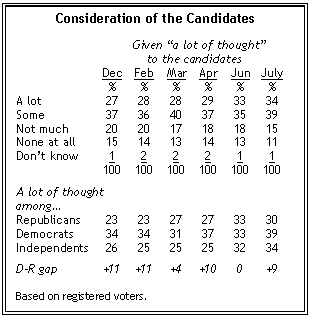
Despite the intensity of the current campaign, the proportion of registered voters who say they given “a lot” of thought to the candidates has increased only modestly in recent months. Currently, 34% say they have given a lot of thought to the presidential field, up just one-point from June and only a seven-point increase since December. Another 39% say they have given the campaign “some” thought, while 26% have given little or no thought to the campaign, down from 31% a month ago.
Republican voters are not yet as fully focused as Democrats on the presidential field, perhaps reflecting the general malaise within the GOP since the 2006 congressional election and President Bush’s continuing low support. If anything, GOP partisans are paying slightly less attention to the candidates now than they were just a month ago. Three-in-10 Republicans (30%) now report they have given a lot of thought to the candidates–a 3-point decline in the past month. In contrast, 39% of all Democratic voters are thinking a lot about their choices, rebounding from 33% in June and up 2 percentage points from April. About a third of all independents (34%) are doing a lot of thinking about the candidates, a 9-point increase from April.
The Campaign So Far: Too Much, Too Soon–But Interesting
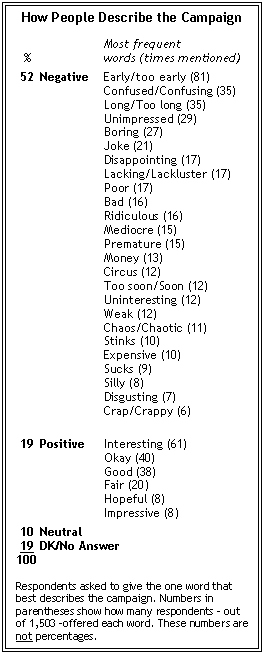
Other survey findings illustrate some of the major reasons why many Americans have yet to sharply focus on the 2008 presidential field. When asked which single word or phrase best describes their impression of the campaign so far, negative descriptions outnumber positive evaluations by nearly three-to-one. The single most frequently mentioned judgment about the campaign: Too early.
Overall, the survey finds that slightly more than half (52%) of the words and phrases that the public uses to describe the campaign are modestly unfavorable (lackluster, mediocre, disappointing), sharply disapproving (joke, ridiculous, stinks) or colorfully but unprintably obscene. Far fewer (19%) offered positive words or phrases, including the second-most frequently mentioned description — interesting, which was followed by okay. The remaining respondents either offered words that were neutral in tone (10%) or gave no answer (19%).
Taken together, several major themes emerge from the more than 400 words or phrases used to describe the campaign. The public clearly remains concerned about the early start of the races. In addition to judging it as beginning too early, other frequently mentioned words and phrases sound a similar note of impatience, including premature, too long and too soon. Many others express a sense of frustration or confusion with the campaign, including confused, chaotic, and circus. Still others reflect disapproval for the candidates and the process such as disgusting and stinks while many Americans seemed to be simply unimpressed or bored: lackluster, uninteresting and weak.
While far fewer respondents offered positive evaluations, most — but not all — of those who did so are broadly impressed. Interesting was the most frequently mentioned positive review while many evaluated the campaign as good and fair or, far less frequently, as hopefull or impressive. Still, many of those with a generally favorable view of the campaign are unwilling to give it an enthusiastic endorsement: Okay is the second-most frequently mentioned word to describe the race.
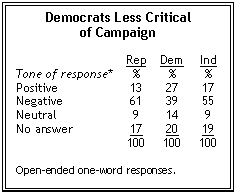
Dissatisfaction with the current campaign is far greater among Republicans than Democrats. By a margin of 61% to 13%, Republicans offer more negative than positive assessments. Independents, too, give words that are far more negative in tone (55%) than positive (17%). Democrats, by comparison, are less dismissive of the campaign. While a 39% plurality of Democrats have negative things to say, 27% offer positive evaluations.
The Democratic Field
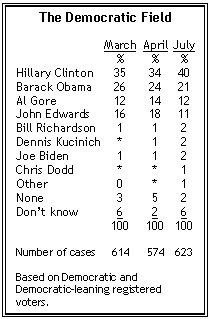
Hillary Clinton has widened her advantage over Barack Obama to nearly two-to-one and has drawn support from her nearest rival from groups that had been among his strongest backers: independent-leaning Democrats and political liberals.
The current survey finds 40% of Democrats and independents who lean Democratic now say they would like to see Clinton win their party’s nomination while Obama is the choice of 21%. In a little over three months, Clinton has more than doubled her advantage over the Illinois Democrat from nine-points in March to 19-points in the current survey. Trailing even further behind are Al Gore (12%), who has not announced his candidacy, and John Edwards (11%), who continues to lose ground.
Collectively, the other candidates in the field are gaining, though no individual has broken out of the pack. The current survey finds 8% of Democrats backing Bill Richardson (2%), Dennis Kucinich (2%), Joe Biden (2%), Chris Dodd (1%), or some other candidate (1%). Three months ago, fewer than half as many Democrats (3%) favored any of these Democratic hopefuls.
Clinton has made significant inroads into voter groups that had broadly supported Obama earlier in the year. For example, Clinton now leads Obama by more than two-to-one (41% vs. 17%) among Democratic-leaning independents.
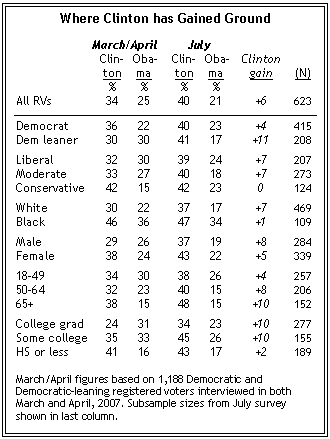
This group was evenly divided at 30% each in earlier Pew polling. Younger voters continue to be one of the core segments of Obama’s base, though Clinton has widened her lead from 4-points to 12-points among Democratic voters under age 50. Clinton also has increased her advantage from 9 percentage points to 25 points among voters 50 to 64 years old, while also gaining among those 65 and older.
Ideology looked to be a critical dividing line among Democrats in earlier polling, but the liberal-conservative divide has largely disappeared as the campaign has progressed. In March and April, liberal Democrats were split between Clinton and Obama (32% vs. 30%, respectively) while conservatives favored Clinton by nearly three-to-one (42% vs. 15%). Today, there is virtually no difference between the preferences of these two subsets of Democratic voters.
And while college graduates favored Obama over Clinton by 31% to 24% in earlier Pew polling, Clinton has opened up a 34% to 23% advantage here as well. Still, less educated Democrats remain Clinton’s strongest backers.
While Pew’s June survey found 80% of Democratic voters saying Iraq was very important to their vote, it has yet to become a defining issue in the primary contest. A 56% majority of Democratic voters say that their party’s leadership has not challenged Bush’s Iraq policies enough, but these voters do not express fundamentally different candidate preferences at this stage of the campaign.
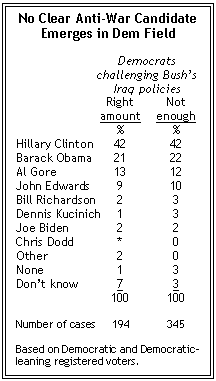
Clinton leads Obama by roughly two-to-one among both voters who want the party to stand up to Bush more firmly and voters who think the party is handling the Iraq issue about right. Similarly, none of the remaining candidates garners significantly more support among those who want to see Democratic leaders mount a greater challenge to Bush.
The Republican Field
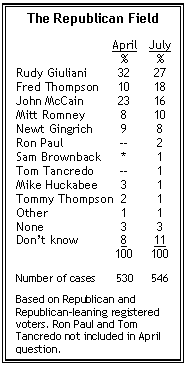
On the Republican side, Rudy Giuliani is now the favorite of 27% of Republican and Republican-leaning voters. The poll finds 18% favoring Fred Thompson, 16% John McCain and 10% Mitt Romney. Since April, support for Giuliani has faded (from 32% to 27%) as has Mc Cain’s (from 23% to 16%), while Thompson has made a significant gain (from 10% to 18%.)
The small overall drop in support for Rudy Giuliani reflects a sizeable shift in opinion among Republican-leaning independents, who are about half as likely to back him today (18%) as they were in April (34%). By comparison, Giuliani’s support among voters who identify as Republicans has remained unchanged (31% in April, 30% today). McCain has lost support in both of these subgroups, though the drop is perhaps more severe among Republican-leaning independents, just 10% of whom favor McCain, down from 21% in April.
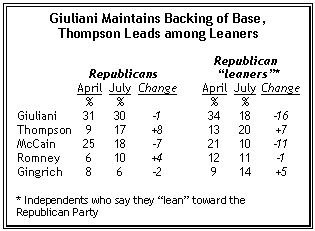
Meanwhile, Fred Thompson has gained support across the board. His overall standing is up eight-points, from 10% in April to 18% today, and his support has grown at about the same rate among both Republicans and Republican-leaning independents. Combined with the steep drop in support for Giuliani and McCain among these voters, Fred Thompson has risen to the top of the field among Republican “leaners”. Currently, 20% of independents who lean Republicans say they favor Thompson, compared with 18% for Giuliani, 14% for Gingrich, 11% for Romney and 10% for McCain. Among voters who identify as Republicans, Rudy Giuliani remains the favored candidate.
The survey also finds that Giuliani’s generally pro-life position on abortion continues to be unknown to most Republicans. Barely four-in-ten (41%) Republican voters, including independents who lean Republican, can identify Giuliani as the GOP candidate who supports a woman’s right to choose when it comes to abortion, while the rest either incorrectly named another GOP candidate (12%) or say they do not know (47%). This is not substantially different from the share of Democratic voters who are aware of Giuliani’s position (39%).

Awareness of Giuliani’s position is higher among Republican voters who have given a lot of thought to the candidates (58% gave the correct answer). There also is an ideological divide: Nearly half (47%) of conservative voters can identify Giuliani as the pro-choice candidate compared with 30% of moderate and liberal Republicans. But still, there is no evidence that this issue is hurting Giuliani among conservatives. Conservative Republicans who know Giuliani’s position are about as likely to support him as those who are unaware of his position.
Many Republicans Want New Direction in Iraq
A majority of Republicans continue to want a GOP presidential nominee who will take a different approach on Iraq than President Bush. Fully 53% of all registered Republicans and Republican-leaning independents say they want their party’s next nominee to follow a different course on the war while 36% want a candidate who will continue the president’s policies.

Support for a new direction is overwhelming among moderate and liberal Republican voters, 69% of whom want a candidate who will provide a different approach to Iraq. But even among conservative Republicans, 46% want a candidate with new ideas, while 43% prefer a candidate who will continue Bush’s policies in Iraq. Not surprisingly, ratings of George W. Bush are the predominant factor in this evaluation. Among the growing minority (currently 26%) of Republican voters who disapprove of Bush’s job performance fully 88% say they want a candidate who will pursue a different approach in Iraq.
Despite this sentiment within the GOP, no Republican presidential hopeful disproportionately appeals to those who favor a different approach on the war. Neither has one candidate emerged as the clear and distinct favorite of Republicans who want to see the administration’s policies continue, suggesting that issues other than the war are currently more powerful in shaping GOP voter sentiments.
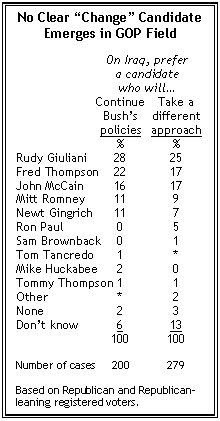
Giuliani continues to lead Republican voters who favor change in Iraq (25%) and among those who support continuing present polices (28%). At the same time, Thompson currently is supported by 17% of those who want change and 22% of those who prefer a continuation of Bush’s strategy. Roughly equal proportions of Republicans who favor a new direction and those who support the administration’s present policies favor McCain (17% of those who favor a new approach support him vs. 16% of those who do not), Romney (9% vs. 11%) and Gingrich (7% vs. 11%). Taken together when the candidates are ranked by the size of their support among those who favor and oppose new policies in Iraq, the order of the field is virtually identical among both groups.
Significantly, however, 16% of all Republicans who say they want to see the nominee take a different approach on Iraq currently have no favorite candidate. That’s double the proportion of undecided voters among Republicans who want the party’s standard-bearer to continue Bush war policies, suggesting the potential for significant shifts in support as candidates fine-tune their positions on the war or their views become better known. Together, these findings underscore the difficulties faced by the GOP candidates over what position to take on Bush policies in Iraq and the importance of issues such as international terrorism, the economy and social concerns to large numbers of GOP voters.
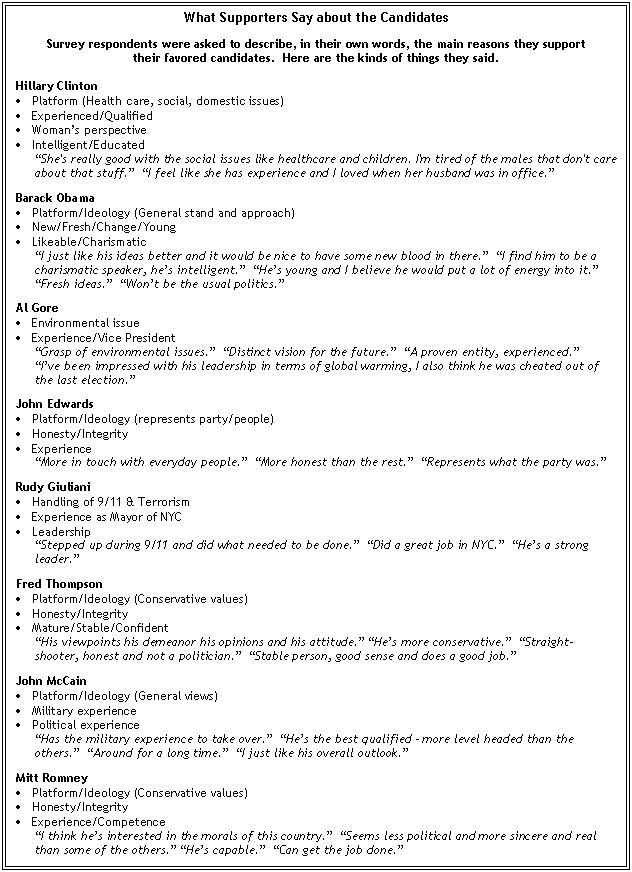
Most Americans Have Yet to See a Presidential Debate

A clear majority of Americans (59%) say they have not yet seen any of the televised face-offs between Republican or Democratic contenders. At the same time, 40% report they have seen at least one debate, double the proportion that saw a debate in January of 2004 and another indication of public interest in a presidential contest that won’t be decided for 15 months. A 2-1 majority of all debate watchers say they found the debates to be “helpful” in learning about the candidates and nearly half (47%) report televised confrontations between the candidates were “fun to watch.”
Even many Americans who are paying at least some attention to the presidential contests have so far skipped watching the presidential debates. Six-in-ten of those who say they have given “a lot” of thought to the candidates have seen a debate, while 40% have not. Among those who have given “some” thought, 40% have seen a debate. At the same time, just 20% of those who acknowledge that they have given little or no thought to the contest have seen a candidate forum. Similarly, barely four-in-10 (42%) of all self-described registered voters say they’ve seen a debate compared with 33 percent of those not yet signed up to vote.
More Democrats (45%) than Republicans (38%) report they had watched a debate. Notably, only a quarter of all moderate Republicans (25%) have seen a debate while 75% have not.
Early Debates Get Mostly Positive Reviews
The presidential debates get generally good reviews from those who have seen at least one candidate forum. Nearly two-thirds (66%) of all debate watchers report the candidate forums have been helpful in learning about the candidates. Women were more likely than men to find the face-offs helpful (71% vs. 61%). Young people, too, found them particularly useful: 77% of those 18 to 29 say they learned something about the presidential contenders compared with 56% of those 65 and older.
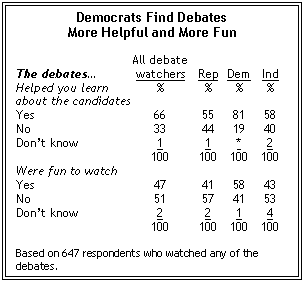
While majorities of both parties view debates favorably, Democrats who have seen a debate found them particularly useful. Democrats are far more likely than Republicans to say the debates helped them learn about the candidates (81% vs. 55%). One reason may be that the most recent Democratic debate, co-sponsored by CNN and YouTube two weeks ago, featured candidates answering questions posed by the public in taped videos, a novel format that was widely hailed in the media as particularly useful and engaging.
Not only have the debates been helpful, they also have been fun for many Americans. Nearly half (47%) of those who have watched at least one say they found the debates enjoyable to watch and 51% did not. While more women than men report that the debates were helpful, more men say they found them to be fun. The partisan gap is equally substantial when it comes to enjoying the debates. Most Democrats (58%) who have seen a debate say what they saw was fun to watch, while most Republican viewers (57%) say they were not fun.
Most Prefer “Real People” Questioning Candidates

The public broadly endorses one key elements of the recent YouTube-CNN presidential debate — having questions submitted from regular people. Asked whether they prefer watching debates that have journalists asking questions of the candidates or regular people asking the questions, 68% choose the latter, while just 17% favor journalists.
The appetite for more direct public involvement in presidential debates bridges political ideology and party identification. Roughly equal proportions of Democrats (69%), Republicans (70%) and political independents (66%) would rather see members of the public — and not the press — question the candidates. Similarly, majorities of three-to-one or more conservatives, moderates and liberals favor non-journalists asking the questions than prefer that the candidates be questioned by the media.
But some modest demographic differences did emerge. Significantly larger proportions of blacks (84%) than whites (66%), 18 to 29-year olds (77%) than those 65 or older (57%) and women (71%) than men (65%) prefer that members of the public question presidential hopefuls in televised debates. Non-college graduates by a 6-1 majority are more comfortable with citizen questioners. In contrast, the most highly educated are easily the least likely to prefer a member of the public to a reporter. Among those with postgraduate college degrees, barely half (53%) say they want questioners to be regular people while 30% prefer journalists.
CNN/YouTube Debate
A majority of the public either watched or heard about last week’s CNN/YouTube debate — 13% watched it and another 42% heard about it in the news. Democrats were only slightly more likely than Republicans to have watched the debate (16% vs. 11%) while 13% of independents tuned in. Nearly equal percentages of Democrats, Republicans and independents heard about the debate in the news. Older Americans were more likely than younger ones to have watched or heard about the debate (62% of those age 50 or older either watched or heard about it compared to 51% of those under age 50). College graduates were much more likely than those without a college degree to have heard about the debate.
Among all of those who either watched or heard about the debate, the consensus seems to be that, in spite of all the hype, it wasn’t much different from more traditional debates. Many did find the new format entertaining. When asked to compare it to more traditional debates in terms of being interesting and entertaining, 34% said the CNN/YouTube debate was better (12% said it was worse in this regard and 44% said it was about the same).

When asked how the YouTube debate compared to past debates in terms of addressing a wide range of topics, asking the candidates challenging questions and helping viewers learn more about the candidates, majorities in each case said it was about the same. Where people did see differences, the reviews for the YouTube debate were generally positive. Three-in-ten said it was better at addressing a wide range of topics, 9% said it was worse. Nearly as many (29%) thought it was better when it came to asking the candidates challenging questions (12% said worse). And 28% thought it was better in terms of helping them learn about the candidates (12% said worse).
Democrats had a more positive view of the debate format than did Republicans, although Republicans’ views may change after the next CNN/YouTube debate which will feature GOP presidential hopefuls. Fully 35% of Democrats thought this debate was better than past ones in helping them learn about the candidates. This compares with only 17% of Republicans. Similarly 33% of Democrats thought the debate was better in terms of addressing a wide range of topics (vs. 19% of Republicans), and 35% said it was better when it came to asking the candidates challenging questions (vs. 17% of Republicans).
Young people, particularly those under age 30, were more enthusiastic about the debate format than their older counterparts. They were more likely to give the debate positive marks for helping them learn about the candidates, addressing a wide range of topics and being interesting and entertaining.